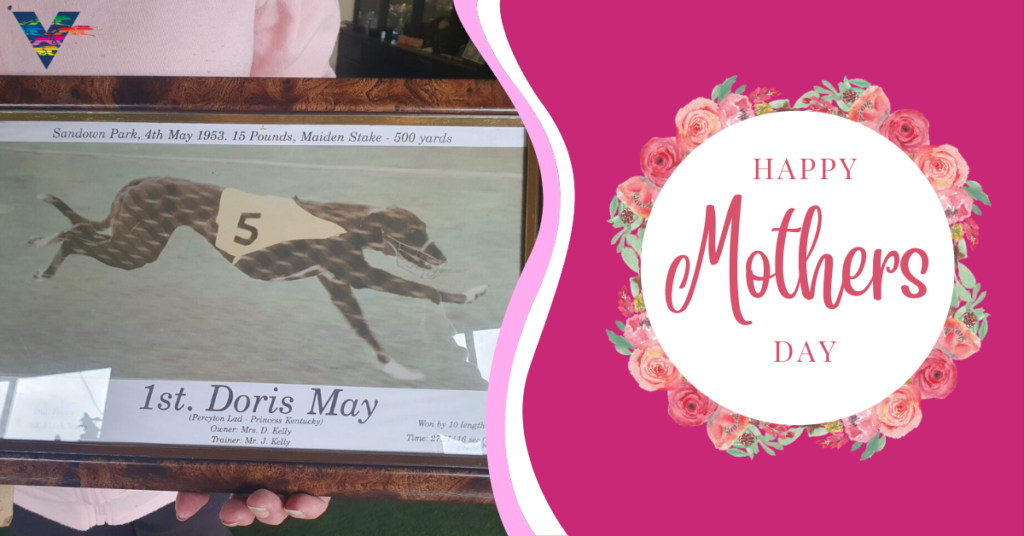1950s Melbourne, at face value, was a little dull. Men had returned from the war, and women had returned to the kitchen, providing the late great comedian and satirist Barry Humphries with marvellous inspiration for his character, housewife, Dame Edna Everage.
However, during the 1950s not all Melbourne housewives were created equal. One such woman was Doris May Kelly.
As a housewife, in the respectable Melbourne suburb of Camberwell, Doris was also a highly sought-after dressmaker, with clients including Barry Humphries’ mother. By 1950s standards, such polite acclaim should surely have provided Doris Kelly with a level of respectable satisfaction beyond that of her housekeeping duties.
But Doris dared to crave a little bit more. So, together with her son John, they became greyhound trainers. And, in defiance of the convention of the times, the very stylish Doris May Kelly unknowingly began to ‘fashion’ the bloodlines for the next three generations of her family to follow in her footsteps.
The early days of greyhound racing for Doris and John Kelly had them experience victories with their greyhounds at racetracks that are long lost to inner-city development.
Obtaining their first two greyhounds, littermates King Dalton and Doris May (Percyton Lad x Princess Kentucky) in 1950, Doris May won her Maiden event for the mother-and-son training combination at the old Sandown track by 10 lengths! And the Kellys were making a distinct impression on the ‘not so dull’ Melbourne greyhound racing scene. In 1953, at Napier Park, North Essendon, winning the Beddome Cup, the Kellys runner, King Dalton, defeated a heavily backed greyhound prepared by legendary trainer and bookmaker, the late Carl Haas.
“I can remember going to Sandown, when they raced on the other side of the railway line.”
During the 1950s, women were not formally acknowledged as greyhound trainers, irrespective of their actual input. And all press and race book listings from this period document Doris Kelly as a greyhound owner and her son John Kelly as a greyhound trainer. Away from the racetrack, Doris was heavily involved with the breeding, rearing, feeding and training of all her greyhounds.
It would be John’s little sister, Doris Jr, some 14 years younger than her brother, that would be a part of the first generation of Australian women involved in racing, who would finally be acknowledged publicly for their actual training efforts.
Fast forward to today, Doris Jr, now Doris Toner, is not quite an octogenarian. And, I was delighted to join Toner recently, when she recalled to me some of her earliest greyhound racing memories.
“When I was about six or seven, I can remember going to a lot of racetracks, many that no longer exist. I can remember going to Sandown, when they raced on the other side of the railway line, but only faintly, going over there with my brother and mother.
“We didn’t breed a lot of litters; we never had a lot of dogs. Just the odd few but they were pretty handy, and I always helped. We used to all go as kids, I used to be the little one, and we went everywhere.”
I couldn’t help but ask Toner, what inspired her mother back in the 1950s to become involved with greyhound racing?
“Mum liked to gamble, I think, and both mum and John loved
the dogs.”
“Mum liked to gamble, I think, and both mum and John loved the dogs.
“At the old Geelong track, near the old Ford factory, mum wanted to have a bet, so she told me to go and find John, because she wanted to have 10 shillings on this dog. I couldn’t find him anywhere, so I was getting all flustered. Anyway, I went up to some bloke and said, ‘my mum wants 10 shillings on this dog, and I can’t find my brother, can you put this on for me please? So, he did, and the dog won! The man was very impressed and gave me the winnings, which I took back to my mum. I can’t remember how old I was, but I was pretty young.”
Educational standards for Australian women in the 1950s and 1960s centred mainly around home economics, stenography and typing. So, knowing full well Toner had the ‘greyhound racing bug’ early in her life, I was curious to find out how she could see her life developing, back then.
VS: Doris, what were you thinking approaching secondary school? Were you thinking of a career?
DT: “Not really. Do you know what I used to do? This was in primary school, I had the Sporting Globe, the pink pages. I used to have that in my school desk, this was when I was 11 or 12. I used to look at it, instead of what I was supposed to be learning. But going into senior school… I didn’t last. I left school at 13. Going on to help my mum with the greyhounds and her dressmaking work, I used to do all the hems on the dresses that she made. Jack used to take mum and I to the greyhounds. He would sit in the car if we didn’t have a runner, while mum and I went in. Mum liked to have a flutter. And I used to always try to make myself look older because you had to be 21 back then to have a bet. I was a bit naughty.”


